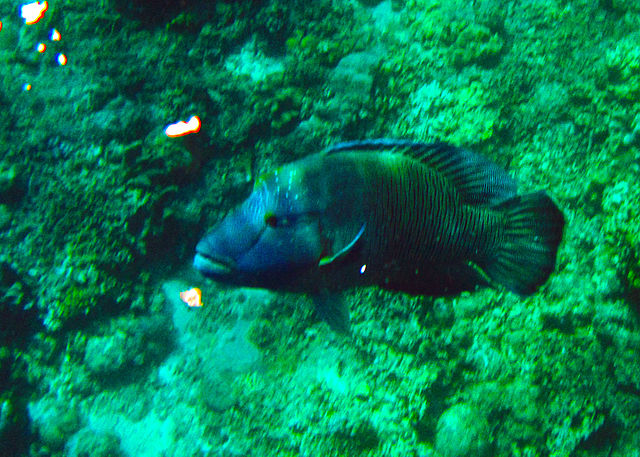Apo Reef

A 2 metre long Giant Napoleon Wrasse swimming at a depth of 10 metres in the waters of Shark Point at Apo Reef.
Photo: Ervin Malicdem. The photo was taken during during the mapping
expeditions undertaken by Schadow1 Expeditions at Apo Reef, Philippines.
Share this page:
Apo Reef is a large 34 square km (13 square mile) reef located about 28 km (17 miles) west of Mindoro island in the northern Philippines.
The reef is home to almost 450 species of coral and about 300 species of fish (including hammerhead sharks, barracuda, manta rays, angelfish, buat fish, yellowmargin trigger fish, surgeon fish, and tuna) as well as turtles and other marine creatures.
With this abundance of corals and marine.species, Apo Reef is seen as "heaven on earth" for divers and snorkellers.
Apo Reef is a tropical atoll formation that is roughly triangular in shape. It stretches roughly 26 km (16 miles) from north to south and 20 km (12 miles) from east to west. The whole atoll formation is cut through by channels and by two lagoons featuring bottoms of fine white sand.
Actually the whole of Apo Reef is submerged except in three places where the corals rise above the surface of the ocean. The corals in the those three places creat the three islands known as:
-- Apo Island,
-- Cayos de Bajo (Spanish for "keys of the bank") (also known as Timangkapan), and
-- Apo Menor (Spanish for "lesser Apo") (also known as Binangaan).
The lesser of these islands, Apo Island, is 22 hectares (54 acres) in size and is home to the Apo Island lighthouse that warns passing ships of the navigation hazard that is the submerged reef.
Protected by Law
In the past many of the reefs in the Apo Reef atoll formation were destroyed by dynamite fishing.
Fortunately the Philippine authorities have taken measures to stop such activities and all fishing was finally in 2007 banned in the Apo Reef area following a survey by the World Wide Fund for Nature (WWFN).
Furthermore, federal legislation has been enacted to formally protect Apo Reef -- first in 1980 (by President Ferdinand Marcos) as a "marine park" and then in 1996 (by President Fidel Ramos) as a "protected national park".
In 2006 the Philippine Department of the Environment and Natural Resources submitted the reef to UNESCO for listing as a World Heritage Site.
How to Visit Apo Reef
The best months for visiting Apo Reef are March, April and May.
Camping is available on Apo Island. Bring your own food and plenty of drinking water (5 litres per day). A permit is required for camping. Be warned: there are lots of insects after sundown on this island -- so make sure you are firmly zipped up inside your tent as night falls.
There are no regular transport connections to Apo Island and Apo Reef.
If you are on Mindoro island, there are two options:
-- charter an outrigger boat from Sablayan on Mindoro's west coast
-- if you are staying at Pandan Island Resort, arrange a day trip or a multiday trip (e.g. 5-15 days) to Apo Reef through the resort's scuba diving centre.
You can also book tours from dive operators in Manila and in Coron Town, Busuanga, Palawan. Many of these tours offer accommodation on live-aboard boats -- so there will be no need to camp or look for other accommodation.
Share this page:
Author: David Paul Wagner
(David Paul Wagner on Google+)